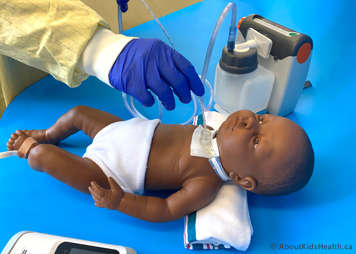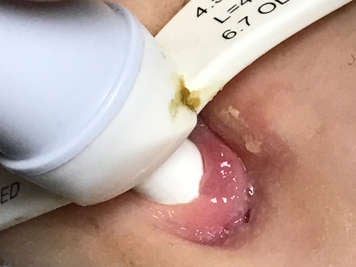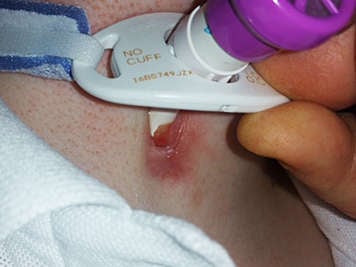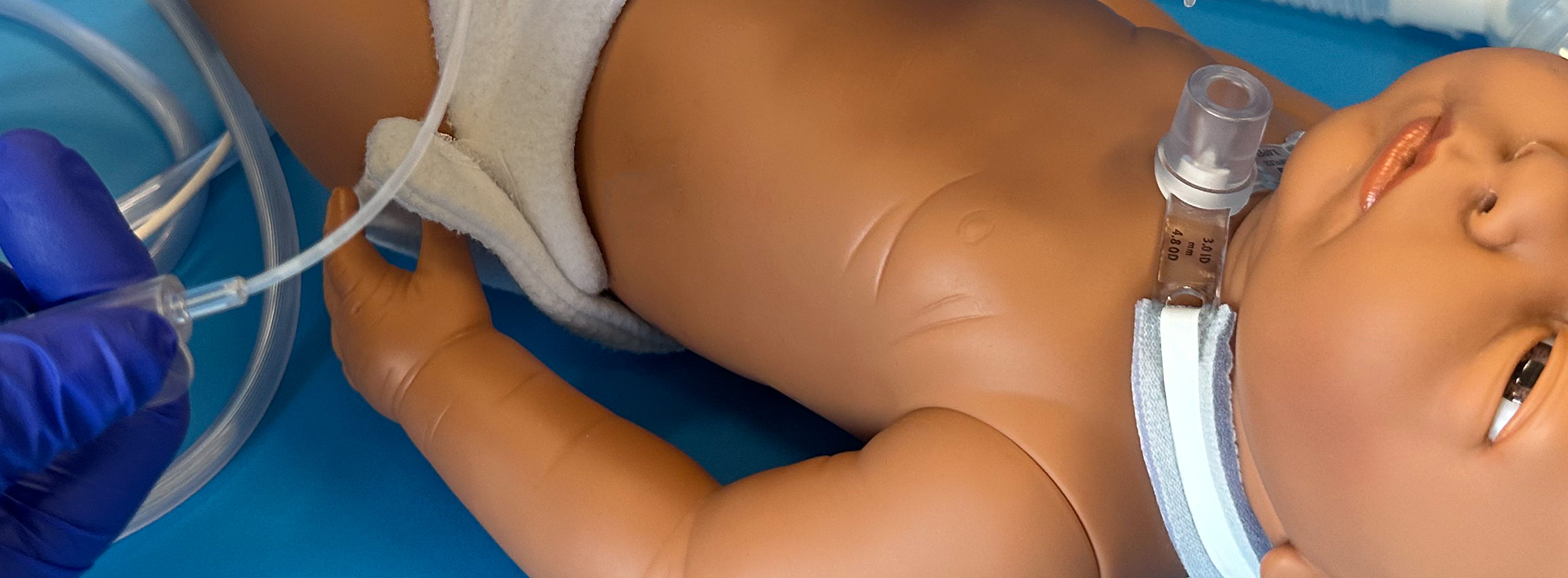
At the end of this chapter, you will be able to:
- discuss when to perform stoma care
- demonstrate how to perform stoma care
- recognize common stoma complications
Your child’s stoma is the opening in their neck for their tracheostomy tube. The tracheostomy tube keeps the stoma open.
What is stoma care?
Stoma care involves cleaning the skin around the stoma. Good stoma care will help prevent infections, irritation and odor. Remember to keep the stoma and neck area clean and dry throughout the day.
How often should I care for my child’s stoma?
You should clean the skin twice a day, first thing in the morning and just before going to bed.
Clean the stoma more often (every eight hours) if the skin is swollen, red or tender to the touch. Each stoma care session should take about 15 to 20 minutes.
How do I clean my child’s stoma?
Before you start

- Make sure your child’s tracheostomy tube has been suctioned and your child has recovered (is breathing normally again and not coughing).
- Make sure the tracheostomy tube is stable and not at risk of falling out while you clean the skin.
- Gather your equipment and supplies.
Stoma care supplies
You will need:
- tracheostomy stoma cleaning supplies (see below)
- emergency tracheostomy kit
- additional equipment and supplies
Organize these supplies in one area in your home so that you can access them easily.
Tracheostomy stoma cleaning supplies
- sterile, distilled water or sterile normal saline
- clean cotton tipped applicators (single use, medical grade, non-fraying)
- gauze (you can use gauze to clean and dry instead of swabs)
- You may wish to use clean non-fraying pre-cut gauze to place under the flange after cleaning. Non-fraying material is important because it avoids fibers being shed and possibly inhaled.
- If you do not have pre-cut gauze, you can fold pieces of non-fraying 4x4 gauze and place on either side of the stoma.
- disposable container (or clean cup that you can reuse) for water
- wet facecloth and dry facecloth

How to clean the stoma
Please note: the steps below describe stoma care done by family caregivers. Home health-care providers should follow their organization/agency guidelines for PPE.
-

Remove any wrapped supplies from their packaging and prepare them as follows:
- Check that you have the emergency tracheostomy kit, suction machine and supplies, manual resuscitation bag, oximeter (if recommended by your child’s health-care provider), oxygen and good light source.
-

Prepare any medication that your child’s health-care team has prescribed for your child’s stoma. This may be prescribed if there has been redness, irritation or granuloma growth at the site. Regular pre-cut gauze or specialty gauze (e.g., Mepilex, Allevyn, Kapitex) may also be prescribed. Prepare these items as needed.
- Your child’s ear, nose and throat (ENT) surgeon may also recommend the use of medications for any granulomas or stoma skin issues (e.g., silver nitrate, Ciprodex, steroids). Use these as prescribed.
- Put down a clean towel or have a clean area near the child to prepare the supplies needed to clean the stoma.
- Pour the sterile water or sterile saline into the clean disposable cup. Place at least 8 small swabs or 4 large swabs into the water or saline for soaking. Also set aside dry swabs for drying the area after cleaning.
- If you are choosing to use gauze, soak about 4 pieces of gauze with sterile water or saline and set aside an additional 4 pieces of gauze for drying the stoma after cleaning.
- Prepare and cut to size tracheostomy ties to change if they are wet or soiled.
- Roll up a small towel. This will be used to place under your child’s shoulders.
-

It is easiest to have infants and small children lay on their backs. Place a small, rolled towel behind their shoulders and remove or loosen their shirt. This will help extend their neck and make the tracheostomy tube site easier to see. Older children can be seated. Make sure your child is comfortable in this position.
-

Gently remove your child’s old dressing (if your child uses it) and discard right away. If the dressing is stuck with dried secretions, gently apply sterile water or saline to soak it off.
- Check the colour and amount of mucus and if there is an unpleasant smell. Contact your health-care provider if needed.
- You do not need to take off the ties to clean the stoma. Instead, you can loosen the ties but keep them attached, which will allow you to see and clean the stoma site. In some cases, the ties may have to be taken off one side for better visualization, however, extra care must be taken in this case to ensure that the child’s tube remains secure during stoma cleaning.
Keep the tracheostomy tube stable even if you are loosening the ties. Hold the tube with one hand while cleaning or have another person hold it secure while you are cleaning. This decreases the risk of the tracheostomy tube falling out during the cleaning.
The buildup of secretions and the rubbing of the tracheostomy tube can irritate the skin around the stoma. Check under the flange and the skin around the stoma for the following:

A dirty flange, crusting on and under the tracheostomy tube and red skin of granulation tissue around the stoma 
Redness and granulation tissue around the tracheostomy stoma - redness or swelling
- thick yellow or green secretions
- crusting or dry secretions
- a bad or strong smell
- pain or soreness around the stoma
- extra granulation tissue (a build-up of skin cells)
- rash (Yeast infection is a common rash that you may notice. It appears red and blotchy and sometimes with red dots. You may also notice the skin looking shiny, oozing or crusty.)
- bleeding
- change in the look of the stoma (Check the stoma to see if it is wider than usual. Normally, the stoma hole diameter is close to the size of the tracheostomy tube size. Monitor the stoma to ensure it is not wider. If it is, contact your child’s health-care provider.)
- any other change in the stoma
Be familiar with any changes and what you need to do to manage them. If you notice redness, tenderness or a foul smell, clean the stoma more frequently. Your child’s health-care provider may prescribe something to place on the area. Do not apply creams or ointments unless prescribed. Notify your child’s health-care team and/or wound care nurse (if you have been referred to one) as soon as you notice any problems.
- redness or swelling
Pick up the pre-soaked swab or gauze. Gently clean the skin with the swab, using each swab for only one wipe before throwing it away.
-

Wipe outward from the stoma.
-

Clean the skin under the tracheostomy ties and in any skin folds in the neck. Clean from the edge of the stoma outward.
- Clean away all crusted secretions from under the flange and on the outside of the tube.
-
-

Dry the skin with dry swabs or gauze. Pat dry or very gently wipe outward. Do not press down too hard.
-

If your child’s health-care provider has prescribed gauze (to reduce friction of the tracheostomy tube, for drainage, for added comfort etc.) please insert the gauze at this step. Gently insert new pre-cut dressing around the stoma. Keep the ties on. You may wish to loosen the ties if they were not already loosened during stoma cleaning. Do not twist the tracheostomy tube, pull on the flange of the tube or push the tube in too firmly. Push the dressing under the flange.
Please note: Gauze under the flange can make it more difficult to see the stoma area. This means that you may not immediately be able to see that decannulation has happened, especially for young infants with shorter tracheostomy tubes. Please take extra precautions when using gauze.
-

Check to ensure ties are secured properly. You should be able to fit one finger between the tie and your child’s neck. Your finger should be able to go all the way around the neck evenly.
- Throw the dirty water into the toilet.
- Place dirty swabs or gauze in a plastic or paper bag and throw the bag in the garbage.
- Clean the water containers.
- Wash your hands well.
- Gather the clean supplies so that they will be ready for the next cleaning.
What is a granuloma?
A granuloma is an extra growth of tissue that is common for children with tracheostomies. A granuloma can grow around the stoma, inside the stoma or on the trachea. Rubbing (friction) of the tube irritates these areas, which causes granulomas. Granulomas can also be caused when there is excess moisture.
Granulomas have the following characteristics.
- Usually appear red or pink and moist.
- May bleed if they become irritated because they have a lot of tiny blood vessels called capillaries.
- Do not have nerve endings and therefore they have no feeling and are not sore or painful.
- Can block the stoma opening if they grow too big.
- Can grow inside the trachea. Your child’s ENT doctor will assess these at regular follow-up appointments and show you how to treat them. The goal of treatment is to decrease the size of the granuloma so that it does not block the stoma.
How is a granuloma treated?
Your child’s health-care provider will decide if the granuloma needs to be treated. Sometimes they do not need to be treated immediately and the health-care provider may ask you to continue to monitor it.
How do I prevent and manage skin breakdown at the stoma site?
Checking the stoma and the surrounding area is important to do often to check for any skin irritation.
To prevent odor, irritation, skin breakdown or infection:
- Do stoma care at least twice daily (see steps above).
- Change dressings as needed throughout the day to keep the stoma and neck clean and dry. Apply any prescribed specialty gauze.
- Apply only prescribed ointments (e.g., antifungal or antibiotic ointments that are petroleum-free and alcohol-free).
- Avoid any rubbing of the tracheostomy tube and secretions that can irritate the skin around the stoma.
- Avoid over tightening the tracheostomy tube ties.
Please contact your child’s health-care provider to discuss options if your child has lots of secretions and you are having difficulties keeping the stoma dry.
Children with new tracheostomies, leaking at the stoma site due to a larger stoma or those using ventilators at home may need to have more frequent stoma care.
Precautions
- The use of petroleum-based products should be avoided especially if oxygen therapy is used. A spark or open flame can cause burns or other damage in this situation.
- Do not use DuoDERM around stoma area. This is a product that repels moisture instead of absorbing it. Leaving this product or similar ones on the skin can prevent healing and may lead to further skin irritation.
- Do not use lotions and powders, as your child can inhale it into their lungs.
- Tell your health-care team as soon as possible if you notice odor, redness, a rash, granulation or excoriation (skin abrasions) at your child's stoma site.
Daily tracheostomy related care checklist
- Check and restock emergency tracheostomy kit.
- Check that the obturator can go in and out of tubes smoothly.
- Check tracheostomy ties (change at least once daily).
- Check stoma dressing (change at least once daily).
- Clean and dry stoma site.
- Suction at least every 4 hours and before feeding.
- Check suction machine is charged, pressures are checked, and canister is emptied.
- Change heat and moisture exchanger (HME).
- Perform humidifier checks (based on type of humidifier used).
- Check oximeter alarms, ensure it is charged and ensure the probe is working properly.
- Clean tracheostomy reusable inner cannula or replace disposable inner cannula (if applicable).
- Check oxygen tanks are not empty or running low.
- Check manual resuscitation bag.
